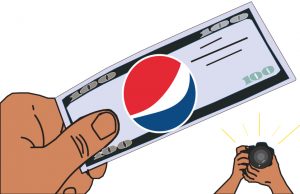Pepsi Offers Peace with an Empty Can
April 27, 2017

On April 5, Pepsi released an ad starring Kendall Jenner making peace with the police at a “protest” by offering a police officer a can of Pepsi. The protest depicted was ideologically ambiguous with signs asking to “join the conversation” and fashionable millennials having a good time.
In response, social media and journalists erupted in a wave of criticisms directed towards how the ad trivializes and co-opts the Black Lives Matter and Dakota Access Pipeline protesters who experienced explicit police brutality.
After initially resisting the backlash, Pepsi finally decided to pull the ad and issued an “apology.”
“Pepsi was trying to project a global message of unity, peace and understanding. Clearly we missed the mark, and we apologize. We did not intend to make light of any serious issue. We are removing the content and halting any further rollout. We also apologize for putting Kendall Jenner in this position,” PepsiCo said.
Although Pepsi’s “apology” focused on their unfulfilled intentions, no failings were specified. In other words, no one from the company seems to be held accountable. Yes, Pepsi may be the organization to blame, but there are many people who have the go-ahead to run this ad.
Joe Pinsker, writing for the “Atlantic,” asks, “How on Earth Does an Ad Like Pepsi’s get Approved?” In the article, Pinsker tracks the process in which an ad such as Pepsi’s may have been produced. Pinsker identifies the conceptual stage of the ad, where creatives develop and pitch ideas, as the stage where an offensive ad can be potentially avoided. Obviously, that was not the case here. This fail on the part of Pepsi has lead many to postulate that the creators were most likely white and of older age. I have a hard time believing otherwise.
However, that is not to say I am satisfied with this postulation because it doesn’t necessarily take an action to prevent such an ad running again. Just this week Shea Moisture ran an ad with a trivializing approach, similar to all lives matter but with hair. The ad equates the problems white women have with their hair to the experiences of black women, in effect ignoring the racialized project that black women’s hair is situated in.
Pepsi’s apology, just like Pinsker’s investigation, merely identifies a mistake and states where that mistake was made. As such, Twitter criticism and Pinsker’s investigation may be critical first steps in identifying the problem, but we cannot stop there. Demands for specific changes in the ad industry, such as a diverse employee body in executive roles or a more racially and culturally informed research process, must be expressed if we are ever to have more politically, culturally and racially conscious ads.
Operating within a capitalistic society, I doubt Pepsi suffered financially enough to take on such steps. Rather it is the fear of “scandal,” an often flighty but potentially career altering term that poses a reason for the apology. Indeed, the apology works to affirm Pepsi’s initial intentions rather than address the consequences of their actions. In addition, Pepsi uses the word apology once in response to Kendall Jenner–the person least likely to be affected materially or socially. And yet, the persons who have the most to lose from this trivializing ad, such as BLM and NODAPL movement, are merely vaguely implied.
Jenner herself has yet to comment or apologize. Many are demanding an apology from her, but if it is going to be another round of what Pepsi has to offer, I think I’ll pass. This is not to say that I don’t think Jenner or Pepsi should not apologize, but that I demand more than a false pretences. Preventing racially and culturally inconsiderate ads take a lot more critical reflection and a substantial deconstruction of media exploitation on the part of ad companies and celebrities alike.





